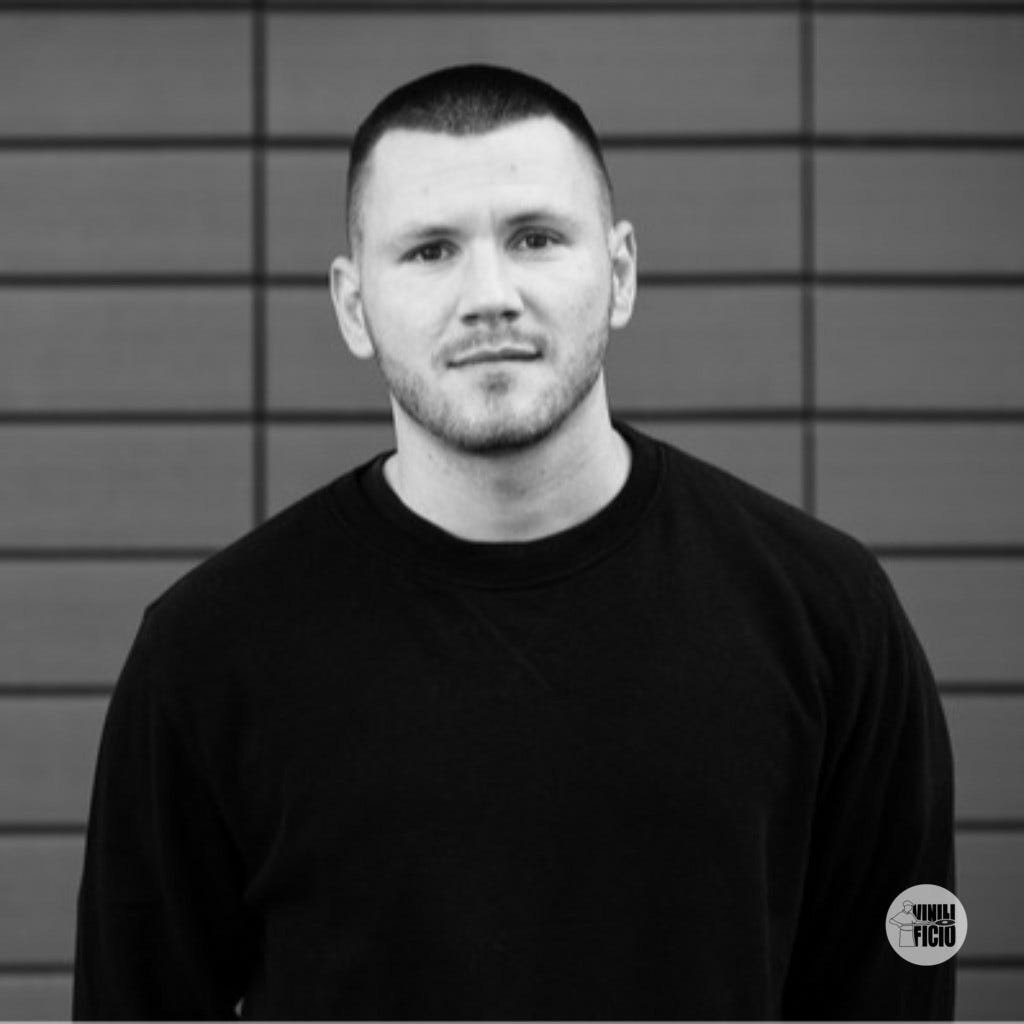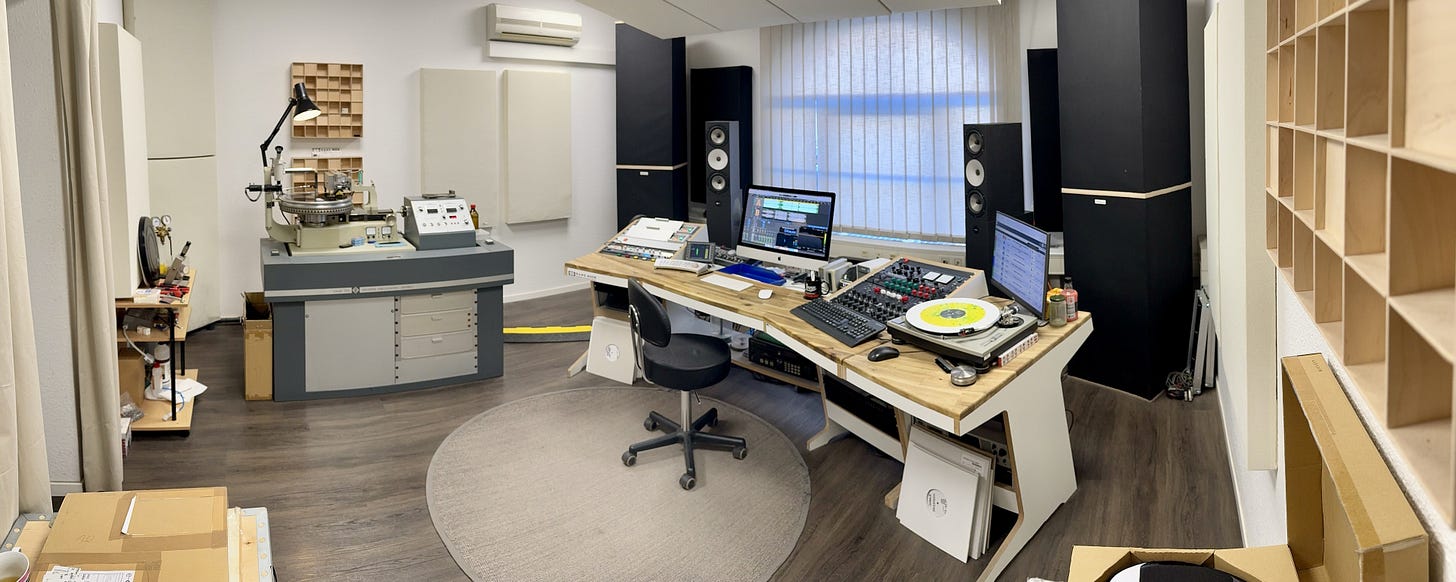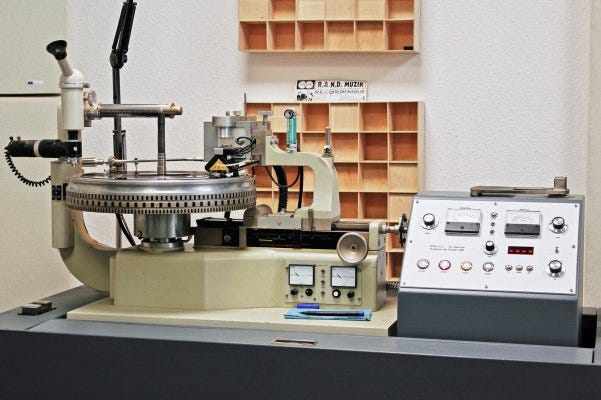Tom Haunstein and the Secrets of the Sound
An in-depth chat with the senior mastering engineer at Rand Muzik
With this interview, we’re turning a new page at Echoes by Vinilificio. This marks the beginning of a new journey into the heart of sound, where we’ll meet and interview colleagues and passionate professionals to uncover the artistry, engineering, and sheer magic behind the craft of music-making.
From sound forgery to the meticulous world of mastering, we’re here to illuminate the hidden hands shaping the music we love. Here are tips and tricks from the masters of the craft.
Enter the world of Tom’s precise touch and artistry.
In the world of sound, where every groove etched into vinyl holds the promise of a story, few names have the reverence accorded to Tom Haunstein. A master of his craft, Tom has carved his legacy at R.A.N.D. Muzik in Leipzig, where since 2012, his work has been immortalised in the etched “RAND” signature—an emblem of quality and a testament to his artistry.
From traditional lacquer cuts to the precision of Direct Metal Mastering (DMM), Tom’s contributions extend far beyond the technical, weaving a profound connection between artist and listener.
We are fortunate enough to collaborate with Tom and witness firsthand his meticulous precision, unwavering dedication, and palpable passion for the alchemy of sound.
This rare blend of skill and soul inspired us to explore his world more deeply. What drives his pursuit of perfection? How does he balance the demands of technology with the heart of music?
We couldn’t resist sitting down with him, peeling back the layers, and discovering what makes this true maestro tick.
How and when did your passion for mastering begin?
My journey started around 1999/2000 when I got into DJing and making beats. A couple of years later, I was part of a small hip-hop group where I served as the DJ and producer. It was all just for fun—a DIY adventure with friends that was far from professional. We even built a little studio, a place to hang out and experiment.
At that time, computers were becoming more accessible, and we could finally take our first steps into the digital audio world using software like Cool Edit Pro and some basic plugins. I quickly became fascinated by manipulating waveforms and shaping sound—it was like a playground for creativity.
As time went on, friends drifted to different cities and pursuits, but I never stopped exploring DAWs and making beats. In 2006, I took things to the next level by studying audio engineering at university. Then, in 2010, I joined R.A.N.D. Muzik initially worked as a pressing operator before moving into the studio a year later.
Has your passion for hip-hop and scratching influenced your professional activity in any way?
Absolutely. Although I’ve always been more drawn to the beats and sounds than the rap itself, listening to thousands of tracks over the years has taught me a lot about structure and production techniques. Understanding song structures and the unspoken rules of various genres—especially hip-hop—has been incredibly valuable in my work.
For example, knowing whether a track is intended for club or home listening shapes my mastering decisions.
When it comes to cutting a proper scratch record, understanding how it’s used in real-life scenarios is crucial. The whole ultra-pitch phrase game is something I genuinely enjoy—it’s fun and fascinating.
How important are listening and music culture in your mastering work?
The older I get, the more open I’ve become to all kinds of music—whether it’s jazz, electronic, or even metal-core. I try to understand the production behind every track and truly appreciate when it’s well-produced and sounds great in quality.
I have the privilege of receiving pre-masters from studios worldwide, ranging from indie to famous names. I learn a lot from these works and apply those insights to my own projects when relevant.
Ultimately, the music needs to resonate with me, no matter the genre or production style.
How important is mastering for a good audio transfer?
Mastering is critical for vinyl. A record can only sound as good as the master it’s cut from.
In today’s digital world, many productions include wild sounds, effects, and frequencies that work fine in a digital environment but can cause serious issues when transferred to vinyl.
You always have to keep the physics of vinyl in mind. Common challenges include phase correlation issues in lower frequencies, excessive sibilance, and overly harsh hi-hats. My golden rule is that if something sounds weird or unpleasant in the digital domain, it will likely become a bigger problem in the analogue world.
Our job is to fix these issues elegantly while preserving the artist's vision.
So, to all producers and engineers, ask yourself if those ear-piercing hi-hats or extreme stereo-effected basslines are necessary for your production. Thank you!
Do you prefer DMM or Lacquer?
I get asked this question almost every week! First, I feel lucky to have access to both, which isn’t the norm for most studios. The definitive “better” choice depends entirely on the project’s goals and specs.
Both solutions have stronger and weaker aspects to the final result.
I often prefer lacquer for DJ use and shorter playtimes (up to 15 minutes). It allows for deeper grooves and maximum volume.
On the other hand, for longer sides (over 20 minutes), I usually lean towards DMM because it’s more efficient with pitch computation, enabling me to maintain volume without compromise. This would be the weaker part of the Neumann VMS70 lacquer lathe.
DMM also has the advantage of slightly lower inner groove distortion thanks to the precision of cutting copper.
How much digital and how much analogue is in your work chain?
It depends on the scenario and the studio.
For pre-mastering, I always use a hybrid approach—digital corrections combined with analogue/tube enhancements and digital finalization.
Some vinyl cuts are prepared entirely in the digital domain, while others use a hybrid setup involving a Neumann SP79 mastering console.
Which equipment (analogue or digital) could you never do without?
Neumann VMS70, VMS82, and coffee!
What are the biggest challenges of being the mastering studio for a major pressing plant like R.A.N.D. Muzik?
The way we operate here isn’t too different from an independent studio. Deadlines and urgent projects are part of the job, but that’s true everywhere.
If there’s ever a sound issue with a pressing—maybe a cut from an external studio—I’m often brought in to provide my opinion, which can be time-consuming.
Some people advise against using pressing plant internal engineers, claiming they don’t care about the quality or aren’t responsive.
I can confidently say that I care deeply about every cut and master, just as much as any independent studio. I’m always happy to answer clients’ questions and will reach out if there’s a significant problem before proceeding with a cut.
Did this interview reflect your own experiences in music production or mastering? We’d love to hear your thoughts!
Whether you’re a professional in the field, an enthusiast, or simply curious about the craft, feel free to share your perspective. Let’s continue the dialogue and explore the artistry and dedication behind great sound together.
Master Your Craft: A 7-Steps Guide to Music Mastering [UPDATED]
Welcome, fellow producers and independent musicians!





![Master Your Craft: A 7-Steps Guide to Music Mastering [UPDATED]](https://substackcdn.com/image/fetch/$s_!lWfd!,w_1300,h_650,c_fill,f_auto,q_auto:good,fl_progressive:steep,g_auto/https%3A%2F%2Fsubstack-post-media.s3.amazonaws.com%2Fpublic%2Fimages%2Fcb11bf0b-98f6-4b9d-8b5a-fc105825e60f_1456x1048.png)